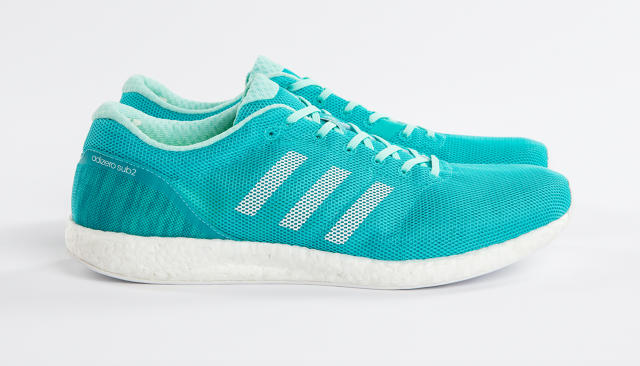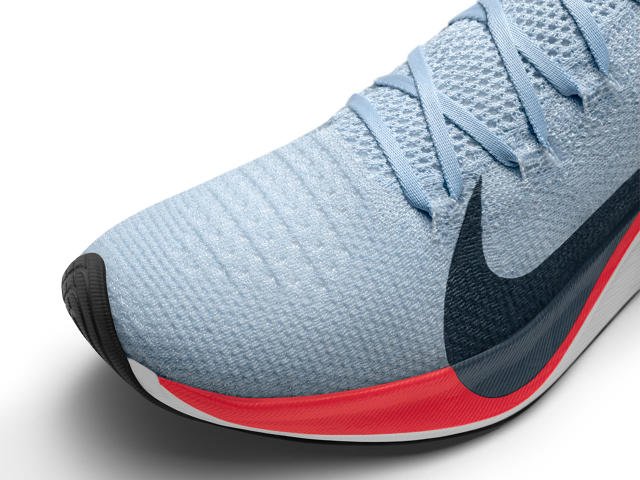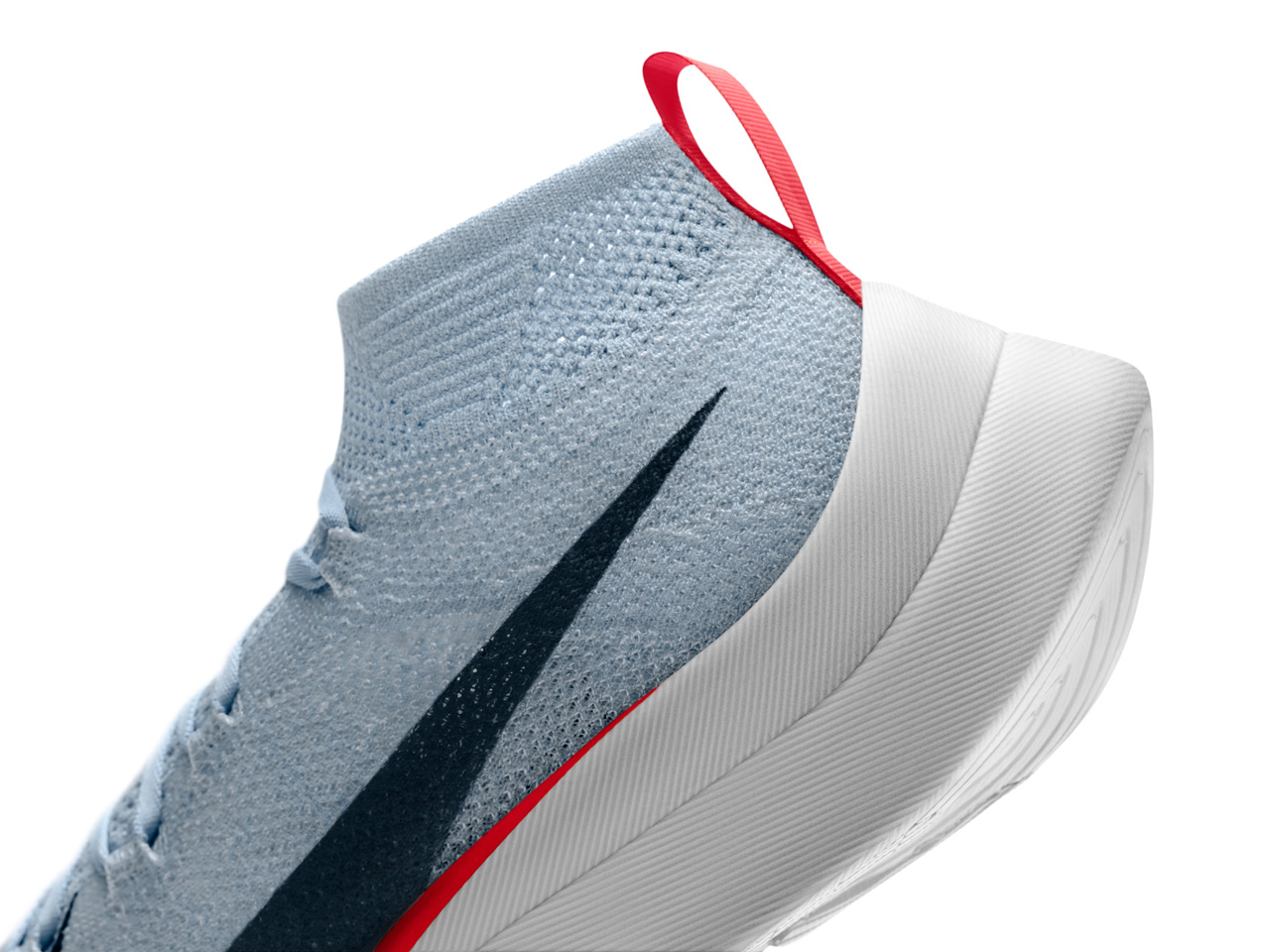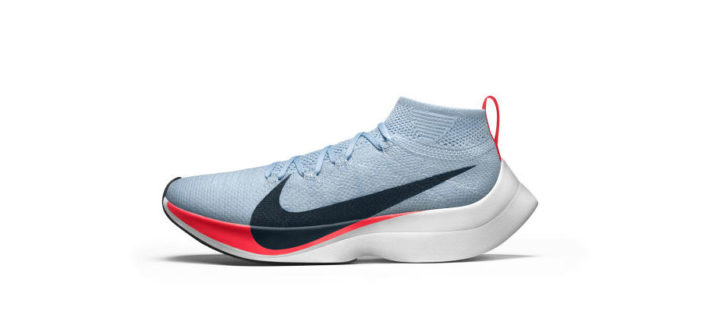Filled with post-EVA foam and a carbon fiber plate, this shoe was designed to increase running efficiency by 6%
No one has ever run a marathon in less than two hours. In fact, the four fastest marathons in history—all within an 18-second margin—are still about three minutes shy of breaking the barrier. Now, Nike hopes that a crazy-looking pair of shoes will help.
They look something like an early ’80s punk haircut, with a white color fin pointing out the razor-sharp tip of a defiant mohawk. But these kicks are anything but counterculture. The Vaporfly Elite is the result of one of the most advanced R&D projects inside the biggest athletic shoe company in the world—they’re the weapon of choice in Nike’s self-assigned goal of breaking the two-hour marathon.
The Vaporfly lineup includes two consumer products and one concept version. Consumers will be able to buy the Nike Zoom VaporFly 4% ($250) and Nike Zoom Fly ($150), each out in June in limited quantities—they come with the promise of adding 4% average efficiency to your running stride. Meanwhile, a few select pros will get access to a customized alternative that Nike likens to a concept car, the Nike Zoom Vaporfly Elite. Each Elite is bespoke, shaped specifically to the athlete’s foot, layered with more than an inch of material padding, and carved in an aerodynamic fin shape, all with the goal of adding 6% efficiency to the athlete’s run.

The numbers might sound small, but when you’re talking about shaving just minutes off a multi-hour run, these tiny differences matter. It’s all about conserving the power lost in every footfall, and recapturing it in your next step. According to Nike, every 1% of step efficiency boosts speed measurably enough that a shoe that’s 6% more efficient should shave a marathon time down enough to break the two-hour mark.
A NEW PARADIGM
In 2009, barefoot running took the industry by storm thanks largely to one book, Born to Run, which profiled Mexico’s Tarahumara tribe, a group able to run 100 miles at a time over rough terrain. Why? Author Christopher McDougall believed it had to do with the fact that they didn’t wear shoes, and he traced a 40-year correlation between the rise of athletic shoes and sports injuries.
The Vaporfly unabashedly bucks this trend.
The project was born inside Nike’s research labs in 2015—and with several conversations with Nike-sponsored long distance runners. Originally, Nike believed that a track-spike inspired shoe would make the most sense. It was light, and featured a rigid internal plate that maintained energy.
“What we heard from [athletes]was, don’t put me closer to the ground. Concrete hurts, even if you’re an efficient lightweight runner,” says Bret Schoolmeester, senior director of Nike’s Global Running Footwear. “26 miles of pavement takes its toll. They needed more cushioning.”
NIKE IS AIMING TO BREAK MARATHON RECORDS WITH THEIR LATEST PRODUCT
Half the problem was solved by Nike’s new ZoomX foam. Nike won’t reveal much about the formula or production of this new, proprietary shoe goop, but the company claims it’s a third the weight of EVA foam—the bouncy polymer inside Nikes and other athletic shoes—and it improves energy returns by 13%. The catch: That energy return only matters if you use a lot of the stuff, which is why the entire line of shoes has an almost comedically thick sole.
“If you’re only using five millimeters of foam, even if you have 100% of energy return, you’re not getting much back,” says Schoolmeester. “There’s definitely a minimum amount of foam you have to get to engage the benefit.” The Zoom Fly shoes deploy a full 1.2 inches of combined midsole and outsole padding—that Nike claims its pro marathoners want for cushioning anyway.

Such thick cushioning would have been heresy just a few years ago, as barefoot running hit its stride and even Nike launched its leaner Free line, but thicker soles are certainly a trend now. Adidas’s Boost technology—which is remarkably similar to ZoomX—led to the company’s fastest selling shoe of all time. Adidas has used Boost to also announce a goal of breaking the two-hour marathon.
But Adidas’s differs from Nike’s in a key way: it does not include a hard plate into the shoe. Nike’s is a carbon fiber spatula that dips dramatically between your heel and your toes—so much so that it actually feels like you’re running downhill. The idea is that your forefoot rolls over this dip with every stride, capturing the energy from your metatarsophalangeal joints upon strike, and rebounding that back into the run. It’s stiff, just like the aforementioned track spikes, to retain as much energy as possible.

As for the upper, it’s an evolution of Nike’s woven Flyknit technology, which now uses high-tensile, monofilament string instead of the traditionally thicker yarns of Flyknit to keep your foot secured to this mechanical platform.
Nike first snuck this technology into a number of its own products for 2016 Olympic runners—two of whom won their qualifiers. Eliud Kipchoge also wore Vaporfly shoes in the 2016 London marathon, which he both won and recorded the second fastest marathon time in history doing so.
WHAT’S NEXT
Now, Nike is planning its own Breaking2 race in Monza, Italy, in which the company will stack the deck as best it can in terms of course, weather, talent, and of course, shoes, to break the record. The event will feature the distance racers Eliud Kipchoge, Lelisa Desisa, and Zersenay Tadese who will run on a 2.4km circular, asphalt track, in an area known for 59-degree weather, overcast skies, and nonexistent winds.
Picturesque? Perhaps not. But it will no doubt be a spectacle all the same. The only lingering question for Nike is on the business end: Even if it manages to break two, how can the company scale this technology to the rest of its line? Should it? The Zoom Vaporfly Elite and its derivatives were designed for the most clock-focused athlete attempting a very particular goal: maximum speed while running body-damaging lengths on hard pavement. But in doing so, Nike itself admits that its runners have been pulled from the ground, their feet strapped to a carbon fiber and a foam platform that’s thicker than ever before—the equivalent of running on spring-loaded pillows.
“It will shift the paradigm as to what’s generally accepted,” says Schoolmeester of ZoomX’s oversized soles—seeming to allude to both their style and function at the same time. However, he admits that their extreme thickness might not fit everywhere across Nike. The company is still discussing whether ZoomX’s tall footprint could be reasonably squeezed into other athletic shoes. Furthermore, Nike will not be killing its more minimal Free line. But it’s still remarkable to note the industry shift afoot, from barefoot philosophy to championing as much springy technology as you can squeeze into a shoe. Especially when looking at Adidas’s successful Ultra Boost line, I can’t help but imagine the future of athletic shoes is skyscraper-tall high tops that turn basketball into that scene from Flubber.

When I ask Daniel E Lieberman, barefoot running advocate and Chair, Department of Human Evolutionary Biology at Harvard, if he thinks Nike could create a shoe capable of breaking the two-hour marathon mark, he says that he believes it could be, while cautioning that our understanding of how the human foot performs while running remains limited. However, all of this obsession with performance-oriented equipment is, to him, beyond the point.
“More importantly, I find the obsession with a sub two-hour marathon depressing,” he says. “When Roger Bannister broke the four-minute mile he did so by working hard on his own. Now we have giant multinational companies and teams of scientists spending millions of dollars to catch an elusive record. Where is the magic and beauty in that? What if we spent those millions of dollars helping average everyday people get fit and avoid injury?”
–
This article first appeared in www.fastcodesign.com
Seeking to build and grow your brand using the force of consumer insight, strategic foresight, creative disruption and technology prowess? Talk to us at +9714 3867728 or mail: info@groupisd.com or visit www.groupisd.com

